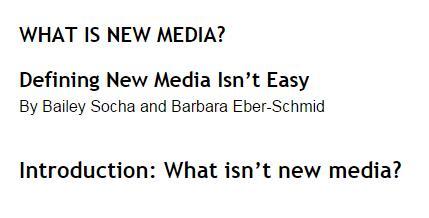e-Learning Ecologies MOOC’s Updates
New Media: What It Is, Isn't, and How It Differs from Old Media
Over the last 15-20 years, the term “new media” has cropped up again and again and more fervently as more and new technologies and mediums for sharing information emerge. When the ways in which we communicate evolve so quickly, it can be difficult to narrow down a set definition of just what new media is. The New Media Institute, a research organization that is devoted to helping the public understand and define new media, has encountered this same issue; when navigating to the “What Is New Media” page of their website, this is what you will see:
While these titles do not bode well for a quick explanation, the writers, Socha and Eber-Schmid, venture their own definition to start:
"New Media is a 21st Century catchall term used to define all that is related to the internet and the interplay between technology, images and sound. In fact, the definition of new media changes daily, and will continue to do so. New media evolves and morphs continuously. What it will be tomorrow is virtually unpredictable for most of us, but we do know that it will continue to evolve in fast and furious ways."[1]
This broad definition satisfied me, but it did not satisfy the writers, as they delved deeper by citing the lengthy Wikipedia definition and laying out a discussion about deciding just what new media isn’t. Though it was hardly the end of their investigation, this segment of their writing struck me as especially poignant:
"Part of the difficulty in defining New Media is that there is an elusive quality to the idea of “new.” The very prospect of being new denotes an event just beyond the horizon, something that has only just arrived and which we are just beginning to get our hands on. Perhaps in searching for a suitable characterization for this network of tools and ideas is the idea of limitless possibility [my emphasis]. Limitless possibility for communication, for innovation, and education is certainly a fundamental element that shapes our conceptions of new media usage from now on."
I want to focus on this idea of limitless possibility in new media for a couple reasons:
1) because I believe it helps us better define new media as a concept no matter how much media changes over time, and
2) because the idea of limitless possibility goes back to how we as users harness the technology and choose to use it.
Going back to the basic concept for this course, Dr. Cope and Dr. Kalantzis (and by extension, all of us) want to find out if new elearning ecologies can really change the way we learn and interact with texts. While I believe we need to dig deeper to truly answer this question, I think that whether we will be positively changed by elearning will be determined by how we choose from those limitless possibilities for utilization that new media afford us.
As many of us have probably seen, there are very good and very bad ways to utilize media in general. In favor of ending on a good note, I will start with the example of a bad use of media and will pick on, of all places, the Columbia University Center for New Media Teaching and Learning. Watch the first minute and ten seconds of this video, and take note of how this hour-long video starts.
There are a few things to unpack in this instance. For starters, I think many of us will agree that watching a video of an event you could not attend in person is very dreary concept. Often the videographer is an amateur, the camera used for filming makes everything appear grainy, and it makes any video or PowerPoint a somewhat meta (and often, inscrutable) experience for the viewer. On top of this, the presenter chose to utilize his PowerPoint presentation just for text that he was already speaking. Another matter to consider is that the media that was being utilized probably could not be considered “new.” PowerPoint has been around for a while and home video cameras, while they are constantly being improved, have not really been “new” since the early ‘80s. In addition, the unprofessional look of the filming leads me to believe that the recording of this event was not a high priority, or was decided on last minute. Lastly (and this is the biggest point), the makers of this presentation and video did not have a real intention in mind as far as the media being used beyond “we want to get it out there.” The presenters did not embrace the “limitless possibility” of media to engage the audience in new ways. To utilize media, especially new media, to truly change the experience of your audience, you have to have very particular intentions and an open imagination.
Now let’s take a look at how new media can be used to open up new avenues for communication and education that did not previously exist. The following example comes from a school district in Iowa that is utilizing new media and social media together to enhance learning.
Let’s break this example down by noting where intention and imagination become clear.
Intention: Though this is on a different level than the learning going on in the classroom, the video itself is well composed, states its purpose right away, and is short enough that learners have a high likelihood of sticking through the whole thing (unlike the hour long lecture above).
Imagination: Instead of fighting students using their phones for non-school purposes the teacher has embraced new media in a class-relevant way.
Intention: Eliciting discussion question answers from every member of the class, including those who may not have participated had the only option been to speak up quickly. This also allows students to talk to one another and share ideas in a format that runs simultaneous to the classroom environment, and outside of it. Encouragement of active knowledge making.
Imagination: Instead of a debate that would only allow a few students to participate at a time, the teacher again turned to phones and tablets to let all parties in on the discussion.
Intention: Allowing every student to learn by doing and receive feedback in person and online.
Imagination: Instead of waiting to discuss ideas that come up in texts, students can discuss online as they read. Classic texts and new media are utilized.
Intention: Getting more students to respond as they will have the content fresh in their minds. The medium can ensure that more students will do the work associated with class readings. Multimodal learning!
Imagination: Using phones and personal devices to update students on due dates and assignment information.
Intention: Students will get messages in a format they will actually check regularly, and they can continue to have a relevant discussions with their classmates thus not putting a dead stop to any fruitful conversations.
Imagination: Using new media and social media to emphasize the lessons of engagement, respect, and proper use of social media platforms.
Intention: Just as Professor Cope mentioned in this week’s video, Active Knowledge Making: Hierarchical or Horizontal Knowledge Relations, we don’t want to just make better workers. We want students to be prepared for anything that comes at them in life and to, above all, become educated and engaged citizens.
I would be interested as we move forward in the course to keep putting this “imagination/intention” test to work, and I hope to come up with other best practices for making elearning ecologies work better for all of us.
[1] Socha, Bailey and Eber-Schmid, Barbara. “Defining New Media Isn’t Easy.” New Media Institute. 2014. http://www.newmedia.org/what-is-new-media.html.




Thank you for sharing this thoughtful insight on PowerPoint usage in virtual learning! It’s fascinating how you pointed out that sometimes presenters overlay slides with text they’re already speaking aloud—this balance between visual aid and spoken word is so important. I appreciate the focus on presentation design that truly supports, rather than distracts from, the message.
For those who might need help crafting polished slide decks or integrating multimedia effectively, there’s a helpful powerpoint presentation writing service I’ve seen here: https://studyfy.com/service/do-my-powerpoint It could be a gentle support for educators or learners juggling content creation. Thanks again for sparking this valuable conversation!